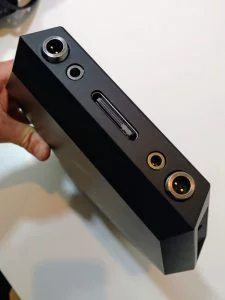Last week I was fortunate to spend some extended time with the then-unreleased HP Z VR Backpack PC. In case you aren’t aware, going wireless with VR is a highly sought-after feature. And as anyone who has experienced tethered VR will tell you, the slightest tug on a headset cable is enough to remind you of your physical surroundings. Suspending disbelief within a completely digital world is the ultimate goal for VR, with a wireless experience being another step towards that.
Unlike the previously released HP Omen X Backpack PC released to the consumer market, the new Z VR is squarely aimed towards the enterprise. Professional users are in mind; those who need VR both in the office, and out. It looks like it could be the perfect hardware for taking out to a customer’s home or office, or in a design office’s showroom. There are some obvious target audiences; those in architecture, or real estate. Or looking at the fringe use cases of virtual site inductions, or a design collaboration session.
The key specs of the PC:
- Intel® Core i7® processor 7820HQ
- Up to 32GB DDR4 RAM
- Up to 1TB storage
- NVIDIA® Quadro® P5200 16GB Graphics
So what are my impressions of the unit?
The design

The first thing you notice when you hold the PC and backpack in your hands is how heavy it feels. At around 4.5kg (including the backpack) it’s heavier than a regular laptop. This can be initially concerning, but then you remember that it’s a wearable device. As soon as it is strapped to your back and you fit the headset, the weight seems insignificant. The freedom you now have to move around your physical space, unobstructed, overwhelms the senses. And the technology fades into the background as an extension of your body.
To the left is a photo of my colleague, where you can see the size of the unit. It’s not much bigger than the size of a regular laptop. Being quite thin the PC sits close to the user’s back to reduce the centre of gravity, but not too close. The side vents expel heat from the processors. Therefore with the PC sitting slightly off the user’s back provides for better air circulation and comfort for the user.

The backpack’s harness is sturdy. Made from durable fabric much like a camping backpack, and with what looks to be a plastic support to mount the PC. To mount, the PC simply slides down over a few brackets and clips into place.
And this leads to an important aspect of the Z VR Backpack PC. It is also a fully functioning computer. Unclipping it from the harness and docking into the HP Z VR Dock provides a desktop PC. If your the kind of professional which spends 50% of your time in the office designing, and the other 50% with customers, then this could be an all-in-one solution. Note though, that when outside the office you will need a small (portable) monitor of some kind to plug the PC into, or TV. I’m not suggesting it is perfect.
At the base of the PC are ports for docking and charging, and for plugging in the two hot-swappable batteries. Even though the PC has an inbuilt battery, it will only last around 10-15 minutes before hibernating. This is more than enough time to un-dock, mount to the harness, and connect to the batteries. While on external battery power I didn’t time usage, but it seemed to get around 45-60 mins. This should be more than enough time for a presentation to a customer. If not, then with more hot-swappable batteries usage time can be extended.
As for the top of the PC, this where everything plugs in. There is a HMD power port, 2 USB 3.0, 1 HDMI 2.0, 1 mini DisplayPort 1.3, 1 Thunderbolt (USB Type-C connector), and 1 headphone/microphone combo.


To get a VR scene up and running, I first had to plug the PC into a monitor using either the dock or the mini DisplayPort. This allows the PC to act as a PC to begin the VR software session. The software I used was Enscape running on Revit 2018, and Autodesk Live. Once the VR session has started, the PC is disconnected from the monitor and it changes over to the VR headset for use.
The PC is reported to also have Miracast support via Windows 10. Miracast is a wireless display protocol, capable of transmitting HD video to an external display. This provides non-participants with the ability to mirror what the VR user is viewing. Some TV’s have Miracast support, and if not then Miracast dongles can be plugged into unsupported TVs and monitors. Unfortunately, I did not have a Miracast capable device at hand to test this out.
Performance
As for the performance, there’s not much to say. Given the higher-end specs of the PC, you would expect it to perform well for VR, and from what I was testing it for, it did. I would expect that as the hardware starts reaching customers, then performance benchmarking websites will do more in-depth reviews. So I will leave that to the hardware experts.
What I can also comment on was when connected to a HP Z Display Z34c, 34-inch ultra-wide curved display. While not running in VR, the PC had no problem pushing the pixels in a full-screen Enscape or Live session. The experience was buttery smooth and looked great in the ultra-wide format.
Overall this VR-ready backpack does what it’s designed to do. It provides the power required for an optimal software experience, and with the portability. But it doesn’t come cheap. It will set you back a little more than a regular VR gaming laptop. Although, since it doubles as a desktop workstation there is an opportunity to offset the costs with only having a single PC.
Article Disclaimer: I work for an employer who provides VR solutions and services. Comments are my own, not my employer.
















